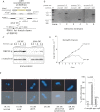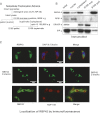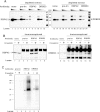The essential polysome-associated RNA-binding protein RBP42 targets mRNAs involved in Trypanosoma brucei energy metabolism
- PMID: 22966087
- PMCID: PMC3479388
- DOI: 10.1261/rna.033829.112
The essential polysome-associated RNA-binding protein RBP42 targets mRNAs involved in Trypanosoma brucei energy metabolism
Abstract
RNA-binding proteins that target mRNA coding regions are emerging as regulators of post-transcriptional processes in eukaryotes. Here we describe a newly identified RNA-binding protein, RBP42, which targets the coding region of mRNAs in the insect form of the African trypanosome, Trypanosoma brucei. RBP42 is an essential protein and associates with polysome-bound mRNAs in the cytoplasm. A global survey of RBP42-bound mRNAs was performed by applying HITS-CLIP technology, which captures protein-RNA interactions in vivo using UV light. Specific RBP42-mRNA interactions, as well as mRNA interactions with a known RNA-binding protein, were purified using specific antibodies. Target RNA sequences were identified and quantified using high-throughput RNA sequencing. Analysis revealed that RBP42 bound mainly within the coding region of mRNAs that encode proteins involved in cellular energy metabolism. Although the mechanism of RBP42's function is unclear at present, we speculate that RBP42 plays a critical role in modulating T. brucei energy metabolism.
Figures









Similar articles
-
The RNA-binding protein RBP42 regulates cellular energy metabolism in mammalian-infective Trypanosoma brucei.mSphere. 2023 Oct 24;8(5):e0027323. doi: 10.1128/msphere.00273-23. Epub 2023 Aug 15. mSphere. 2023. PMID: 37581443 Free PMC article.
-
The Trypanosoma cruzi RNA-binding protein RBP42 is expressed in the cytoplasm throughout the life cycle of the parasite.Parasitol Res. 2018 Apr;117(4):1095-1104. doi: 10.1007/s00436-018-5787-9. Epub 2018 Feb 23. Parasitol Res. 2018. PMID: 29473141 Free PMC article.
-
Depletion of the Trypanosome Pumilio domain protein PUF2 or of some other essential proteins causes transcriptome changes related to coding region length.Eukaryot Cell. 2014 May;13(5):664-74. doi: 10.1128/EC.00018-14. Epub 2014 Mar 28. Eukaryot Cell. 2014. PMID: 24681684 Free PMC article.
-
The emerging role of RNA-binding proteins in the life cycle of Trypanosoma brucei.Cell Microbiol. 2014 Apr;16(4):482-9. doi: 10.1111/cmi.12268. Epub 2014 Feb 16. Cell Microbiol. 2014. PMID: 24438230 Free PMC article. Review.
-
Gene expression in Kinetoplastids.Curr Opin Microbiol. 2016 Aug;32:46-51. doi: 10.1016/j.mib.2016.04.018. Epub 2016 May 10. Curr Opin Microbiol. 2016. PMID: 27177350 Review.
Cited by
-
Carbohydrate-Binding Non-Peptidic Pradimicins for the Treatment of Acute Sleeping Sickness in Murine Models.PLoS Pathog. 2016 Sep 23;12(9):e1005851. doi: 10.1371/journal.ppat.1005851. eCollection 2016 Sep. PLoS Pathog. 2016. PMID: 27662652 Free PMC article.
-
Genome-wide analysis of 3'-untranslated regions supports the existence of post-transcriptional regulons controlling gene expression in trypanosomes.PeerJ. 2013 Jul 30;1:e118. doi: 10.7717/peerj.118. Print 2013. PeerJ. 2013. PMID: 23904995 Free PMC article.
-
The regulation of trypanosome gene expression by RNA-binding proteins.PLoS Pathog. 2013;9(11):e1003680. doi: 10.1371/journal.ppat.1003680. Epub 2013 Nov 7. PLoS Pathog. 2013. PMID: 24244152 Free PMC article. Review. No abstract available.
-
RNA Binding Proteins and Gene Expression Regulation in Trypanosoma cruzi.Front Cell Infect Microbiol. 2020 Feb 20;10:56. doi: 10.3389/fcimb.2020.00056. eCollection 2020. Front Cell Infect Microbiol. 2020. PMID: 32154189 Free PMC article.
-
Functional insights from a surface antigen mRNA-bound proteome.Elife. 2021 Mar 30;10:e68136. doi: 10.7554/eLife.68136. Elife. 2021. PMID: 33783358 Free PMC article.
References
-
- Atlas R, Behar L, Elliott E, Ginzburg I 2004. The insulin-like growth factor mRNA binding-protein IMP-1 and the Ras-regulatory protein G3BP associate with tau mRNA and HuD protein in differentiated P19 neuronal cells. J Neurochem 89: 613–626 - PubMed
-
- Atlas R, Behar L, Sapoznik S, Ginzburg I 2007. Dynamic association with polysomes during P19 neuronal differentiation and an untranslated-region-dependent translation regulation of the tau mRNA by the tau mRNA-associated proteins IMP1, HuD, and G3BP1. J Neurosci Res 85: 173–183 - PubMed
Publication types
MeSH terms
Substances
Grants and funding
LinkOut - more resources
Full Text Sources
Molecular Biology Databases
